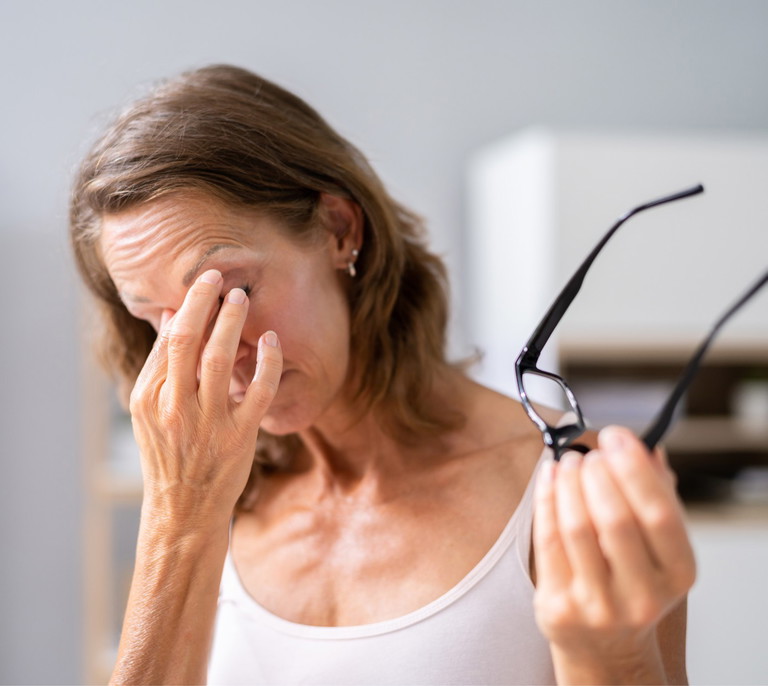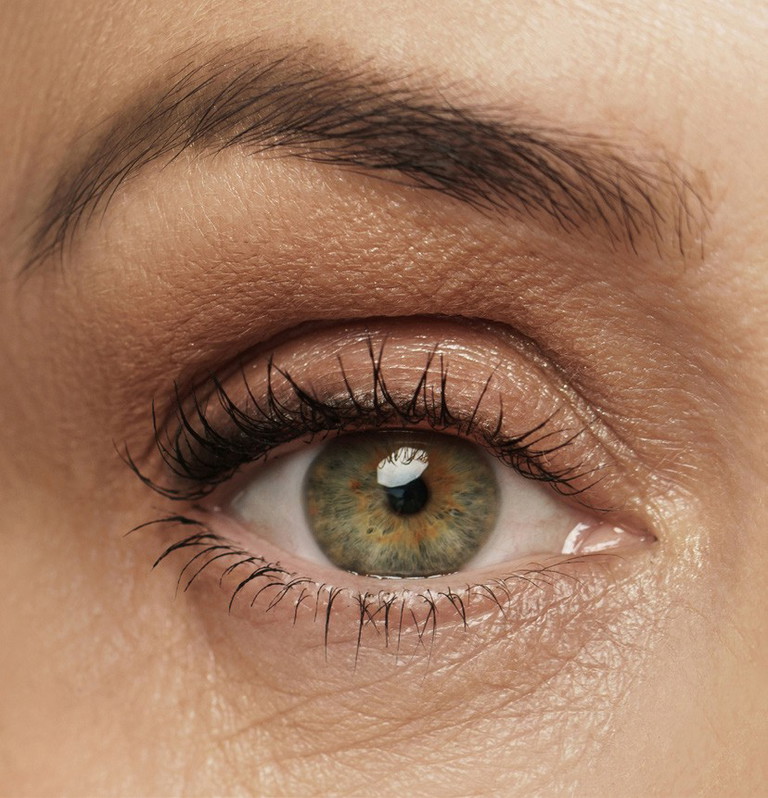miophthalmology
Eye Health and Cosmetics Changing the Narrative
Shifting the narrative toward more positive, empowering conversations about beauty and eye care can give patients new ways to love and care for their eyes. In this article, Dr Jacqueline Beltz explores the opportunities.
WRITER Dr Jacqueline Beltz

“The most common reaction to cosmetics is an exacerbation of dry eye or MGD, and these can be nonspecific, subjective, and difficult to detect”
When we talk to patients about their eye health, the conversations often lean toward warnings and restrictions: avoid this, be cautious about that, and so on. These discussions are essential, but they can sometimes feel heavy or even negative. What we don’t always make time for are the positive aspects – conversations that empower patients to feel good about their eyes, enhance their appearance, or simply enjoy the confidence that their eyes can bring.
Eye health and beauty are not mutually exclusive, and integrating this topic into patient interactions can be rewarding. It might be as simple as chatting about mascara on the way back to the counter or offering tips on makeup application when selecting frames.
The way that we discuss these topics can make a difference. For example, the health of the eyelid margins plays a crucial role in preventing inflammation and addressing issues like dry eye. However, getting patients to comply with recommendations for care can be challenging. This is especially true when we use clinical, unappealing terms like ‘lid hygiene’. This language can inadvertently make patients feel as though they are being unclean or unhygienic, which may create resistance. Instead, framing the conversation around small, manageable changes to their ‘cleansing routine’ – such as incorporating gentle lid and lash cleansing into their usual face-washing ritual – can feel more approachable and positive.
Recommending high-quality, thoughtfully formulated products that are pleasurable to use is also key. Many patients are more likely to adopt these into their routine than suggestions like baby shampoo, which is not designed or tested for delicate eyelid skin or the sensitive eye area, and is not going to complement their other skin care products.
Starting these conversations with confidence requires some background knowledge that isn’t typically emphasised in optometry or ophthalmology training. Understanding how makeup impacts eye health, knowing which products are gentle, and being able to recommend safe cleansing practices can make a big difference for patients.
THE IMPACT OF COSMETICS ON EYE HEALTH
Studies show that around 10% of individuals undergoing patch testing in Europe and the United States have allergies to cosmetic ingredients.¹ In the UK, research found that 57% of women and 31% of men have had an adverse reaction to a cosmetic product.² These figures underscore just how frequently cosmetic products can contribute to discomfort and sensitivity, and sometimes these issues relate to the eyes.
In addition to allergic reactions, makeup products are able to affect the ocular surface, tear film stability, and lid margins, contributing to discomfort or exacerbating existing conditions such as dry eye disease or meibomian gland dysfunction (MGD).3 Makeup can also be difficult to tolerate or not perform as designed when eyes are watery or drops are being instilled.
Dry eye is of course a common concern among patients, particularly as they age. The Blue Mountains Eye Study revealed that 57% of people in Australia over 50 experience dry eye symptoms, with the prevalence being even higher among women.4 Since this demographic also frequently uses cosmetics, it’s essential for eye care professionals to consider the impact of beauty products on eye health and safety.
Cosmetic products used on the face and around the eyes can migrate onto the ocular surface.5 Occasionally, these products can be visualised in the tear film as pigments or particles, and there is some evidence that this product migration might contribute to ocular discomfort.6
Despite challenges, makeup remains an important form of self-expression and confidence for many people. Rather than advising patients to avoid makeup altogether, we have an opportunity to recommend eye-safe options and educate patients on healthier makeup practices.
COMMON IRRITANTS IN EYE MAKEUP
While understanding some potential culprits in cosmetic formulations can help guide patient recommendations, it is also important to understand that the whole formulation may be more important than the list of its particular ingredients. The interactions among ingredients within a cosmetic formulation can significantly influence a product’s safety and efficacy. Ingredients listed are often included in very low percentages, so irritations that occur at high percentages may not be relevant in some cases. Therefore, it’s essential to evaluate the complete formulation rather than focussing solely on individual ingredients.

In Australia, ingredients in makeup and cosmetic products are regulated as industrial chemicals by the Australian Industrial Chemicals Introduction Scheme. This process differs from regulations applied to therapeutic products by the Therapeutics Goods Administration.
There are some particular ingredient categories or product types to be aware of:
Preservatives: Products that contain water must also contain preservatives to prevent microbial overgrowth. Certain preservatives, including parabens,7 benzalkonium chloride (BAK),8 and formaldehyde-releasing agents,8 can cause eye irritation, allergic reactions, or contribute to MGD. Parabens, once a widely used cosmetic preservative, have fallen out of favour in recent years for non-ocular reasons, with many products now labelled ‘paraben-free’. While parabens are well-tested and generally considered safe in most formulations, they are not recommended for use around the eyes, as they have been shown in vitro to be toxic to human meibomian gland epithelial cells,7 which can contribute to dry eye disease.9

BAK, commonly used as a preservative in eye drops, is well known in eye care as a potential irritant and allergen that many of our patients are sensitive to.8 However, it is also found in cosmetics and eye makeup removers, making it important for those with sensitive eyes or dry eye concerns to check ingredient labels carefully.
Prostaglandin analogues (PGA): As eye health professionals, we are aware of the use of PGAs for the management of glaucoma. A known, but not completely understood, side effect of eyelash growth exists.10 PGAs are not approved for cosmetic use in Australia and are not recommended by ophthalmologists due to unwanted side effects such as periorbital fat atrophy, and skin and iris hyperpigmentation.11
Fragrance: Scent is a common additive in cosmetics, including eye makeup. Fragrance (natural or synthetic) ingredients can be a hidden trigger for ocular irritation, redness, and allergic reactions.
Alcohols: Alcohols are used in eye makeup products for their quick-drying properties, lightweight texture, and antimicrobial effects. However, these can also contribute to tear film instability by accelerating evaporation, potentially leading to dryness and irritation, especially in individuals already prone to dry eye disease. While direct clinical evidence linking alcohols in eye cosmetics to dry eye disease is limited, we know that increased tear evaporation – a key factor in evaporative dry eye – can be exacerbated by exposure to drying agents. Given that dry eye disease is often linked to MGD and an unstable tear film, it is reasonable to consider that eye makeup containing alcohol could contribute to symptoms over time, particularly with frequent use.
Waterproof formulas: Waterproof cosmetics contain strong film-forming agents and waxes that resist water and smudging, but they can be harder to remove, requiring stronger removers and more vigorous rubbing that may irritate eyes and disrupt the tear film.
Flaky formulas, glitter, and particles: Products that flake throughout the day, powder eyeshadows, or products containing glitter can deposit particles into the eyes, causing discomfort.
Remember: any ingredient – or combination of ingredients – can potentially cause irritation or an allergic reaction. It’s not always a single ingredient that is to blame; cosmetic formulations are complex, and it’s the entire formulation that matters. A single ingredient in one product may cause irritation, while the same ingredient in a different product may not. This is because other components in the formulation, such as preservatives, emulsifiers, or fragrances, can interact with the active ingredients, affecting how they are absorbed by the skin and eyes. Therefore, a one-size-fits-all approach doesn’t work when recommending makeup products, and there will always be some requirement for trial and error to identify what works best for an individual’s unique sensitivities. Clinical testing, especially ophthalmologistled studies involving people with sensitive eyes are rare, but when present can provide valuable reassurance.
Simply noting ‘ophthalmologist tested’ or ‘hypoallergenic’ on a product does not carry a lot of weight given that, unfortunately, these terms are not regulated. Hopefully, they do signify intent that these products are at least intended to be eye safe or less likely to cause allergic reactions, however, there is no specific set of tests or guidelines required to use those terms. It is not always possible to glean details about specific clinical tests that have been performed, but smaller/independent brands are often more transparent about such details, and sometimes these questions can be asked.
THE ROLE OF OPTOMETRISTS IN MAKEUP EDUCATION
Optometrists are uniquely positioned to guide patients toward healthier cosmetic choices. Here are practical ways to integrate this conversation into your practice:
• Ask open-ended questions like, “Do you experience any eye discomfort after applying makeup?” or “How do you remove your eye makeup?”.
• Educate patients on ingredients by providing simple explanations about common irritants and what to look for in product labels.
• Demonstrate proper removal techniques. Emphasise the importance of gentle makeup removal to protect the delicate eye area. Recommend using a cleansing balm or other product that can break down makeup without harsh rubbing.
• Create educational brochures or handouts with tips for eye safe makeup practices.
• Recommend trusted products. Have a curated list of eye-safe products so you can help patients make informed choices.
TIPS FOR PATIENTS
Here are some actionable tips you can share with your patients to maintain eye health while enjoying makeup:
• Avoid applying eyeliner on the waterline. This can block the meibomian glands, worsening dry eye symptoms.
• Steer clear of waterproof mascara. These formulas often contain drying ingredients and are difficult to remove, increasing the risk of irritation.
• Thoroughly remove makeup. Recommend a gentle cleansing balm to break down makeup while cleansing the lid margins.
• Keep active skincare products away from the eyes. Ingredients like retinoids can migrate and cause meibomian gland atrophy.
MANAGING PATIENT REACTIONS
If you suspect that a patient is experiencing a reaction to a cosmetic around the eye, it’s important to approach the situation with care and clarity. The most common reaction to cosmetics is an exacerbation of dry eye or MGD, and these can be non-specific, subjective, and difficult to detect. But it is, of course, also possible for a patient to experience an allergic reaction that is more apparent. Avoid using language that may unnecessarily alarm the patient. It is essential to remember that anyone can be allergic to any ingredient, even if a product is labelled as hypoallergenic or allergy tested. This does not mean the product is ‘bad’ or ‘defective’, but it does indicate that this particular patient should avoid using that product in the future. Remember to consider other potential culprits, such as makeup removers, eye drops, or differential diagnoses such as viral or seasonal allergic conjunctivitis. Allergies can develop, even to products that have been used for a long time. Companies frequently change their formulations, so the ingredients list on the packaging may no longer be up to date. The most accurate list is often available on the product’s website.
For patients who struggle to decipher ingredients lists, an optometrist or ophthalmologist can be an invaluable resource, helping them identify common ingredients that may be triggering their reactions. The first step in managing any reaction is to discontinue use of the product. Unless contraindicated, recommend a systemic antihistamine. For localised symptoms, unpreserved (chilled) lubricants and a cool compress are typically sufficient to provide relief, although you may also consider topical antihistamine and/or steroid eye drops if necessary. Most allergic reactions resolve within 24–72 hours, but if symptoms persist, further evaluation may be needed.
CONCLUSION
By shifting the narrative from avoidance to empowerment, optometrists can help patients feel confident in their cosmetic choices without compromising their eye health. Educating patients about ingredients, proper application, and removal techniques, as well as recommending trusted products, can foster positive, lasting changes.
The intersection of eye health and beauty is an exciting space – and one that optometrists are uniquely positioned to lead. Let’s embrace it, one conversation at a time.
To earn your CPD hours from this article, visit mieducation.com/changing-the-narrative-eyehealth-and-cosmetics-in-clinical-discussions.
Dr Jacqueline Beltz BMedSci MBBS MSurgEd FRANZCO is a cataract and refractive surgeon. She is a Director of GenEye, and co-President the Australasian Society of Cataract and Refractive Surgeons (AUSCRS).
Dr Beltz has also founded a makeup brand, ‘OKKIYO – Beauty for Sensitive Eyes’.
References
1. Orton DI, Wilkinson JD. Cosmetic allergy: incidence, diagnosis, and management. Am J Clin Dermatol. 2004;5(5): 327 –337. doi: 10.2165/00128071 –200405050 –00006.
2. Willis CM, Shaw S, Wilkinson JD, et al. Sensitive skin: an epidemiological study. Br J Dermatol. 2001;145(2):258 –263. doi: 10.1046/j.1365 –2133.2001.04343.x.
3. Sullivan DA, da Costa AX, Markoulli M, et al. TFOS Lifestyle: Impact of cosmetics on the ocular surface. Ocul Surf. 2023;29:77 –130. doi: 10.1016/j.jtos.2023.04.005.
4. Chia EM, Mitchell P, Wang JJ, et al. Prevalence and associations of dry eye syndrome in an older population: the Blue Mountains Eye Study. Clin Exp Ophthalmol. 2003 Jun;31(3):229 –32. doi: 10.1046/j.1442 –9071.2003.00634.x.
5. Ng A, Evans K, North R, Purslow C. Migration of cosmetic products into the tear film. Eye Contact Lens. 2015;41:304 –309. doi: 10.1097/ICL.0000000000000124.
6. Ng A, Evans K, North R, Purslow C. Eye cosmetic usage and associated ocular comfort. Ophthalmic Physiol Opt. 2012;32:501 –507. doi: 10.1111/j.1475 –1313.2012.00944.x.
7. Wang J, Liu Y, Kam WR, Li Y, Sullivan DA. Toxicity of the cosmetic preservatives parabens, phenoxyethanol and chlorphenesin on human meibomian gland epithelial cells. Exp Eye Res. 2020;196:108057. doi: 10.1016/j. exer.2020.108057.
8. Chen X, Sullivan DA, Liu Y, et al. Toxicity of cosmetic preservatives on human ocular surface and adnexal cells. Exp Eye Res. 2018;170:188 –97. doi: 10.1016/j. exer.2018.02.020.
9. McCulley JP, Shine WE. Meibomian gland function and the tear lipid layer. Ocul Surf. 2003;1(3):97 –106. doi: 10.1016/s1542 –0124(12)70138 –6.
10. Smith S, Fagien S, Beddingfield FC 3rd, et al. Eyelash growth in subjects treated with bimatoprost: a multicentre, randomised, double–masked, vehicle controlled, parallel –group study. J Am Acad Dermatol. 2012;66:801 –806. doi: 10.1016/j.jaad.2011.06.005.
11. Royal Australian and New Zealand College of Ophthalmologists, RANZCO position statement: Cosmetic eyelash serums containing prostaglandin analogues, available at: ranzco.edu/wp –content/uploads/2021/03/RANZCO –Position –Statement –on –prostaglandin –analogues –in – eyelash –growth –serums.pdf [accessed 8 March 2025].
